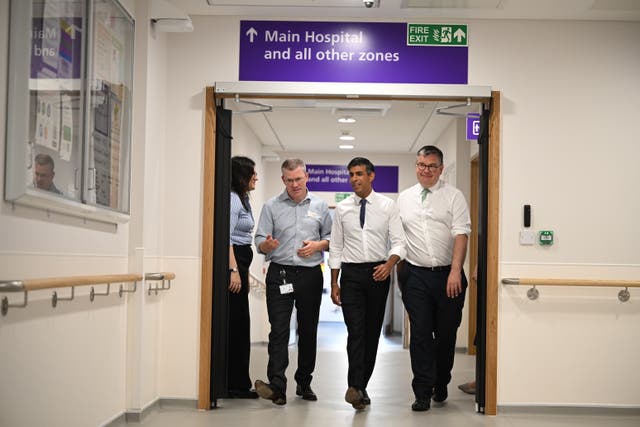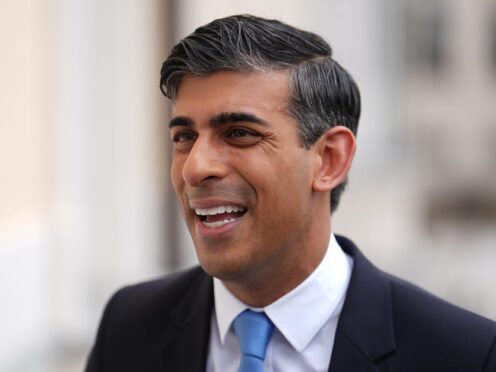Halving inflation and reducing debt were two of Rishi Sunak’s priorities set out for last year.
But figures released on Wednesday show that, while inflation continues to fall towards the target level, national debt has risen.
With some of the Prime Minister’s priorities still to be achieved, work remains to be done before the Government can go into a general election campaign claiming success on all these key issues.

Below, the PA news agency looks at each of his five priorities and summarises progress on achieving them so far this year.
– Halve inflation
The Prime Minister met his pledge to halve inflation in 2023.
Mr Sunak needed inflation to fall to below 5.4% in order to meet his target, and the final figures for last year showed this had been achieved, with inflation falling to 4% by December.

The latest figures published on Wednesday show inflation continues to fall towards the Bank of England’s target of 2%, with price rises slowing to 2.3% in April.
This is the lowest level since July 2021, but the decline was smaller than expected as economists had predicted CPI would fall to 2.1% in April.
However, the Prime Minister hailed the news, saying it is “an important moment for our country, for the economy, and shows that our plan is working”.
– Grow the economy
Growth over 2023 was weak, with the UK falling into a recession in the second half of the year.
Office for National Statistics (ONS) estimates suggest the economy grew by just 0.1% over the whole year, with the first three months of 2023 being the only quarter of the year that saw any growth.
The UK economy rebounded out of recession with faster-than-expected growth over the first quarter of 2024, according to official figures.

The ONS said gross domestic product is estimated to have risen by 0.6% between January and March.
It comes after two quarters of decline – which represents a technical recession – in the second half of 2023.
The International Monetary Fund said the UK economy is set for a “soft landing” as it grows faster than previously expected following recession last year.
But the global financial agency stressed that ambitious structural reforms to improve living standards “are urgently needed” ahead of a general election later this year.
– Reduce debt
The national debt rose over the course of 2023, and remains at levels not seen since the early 1960s.
The latest figures show the UK’s overall national debt was £2.69 trillion in April, or 97.9% of gross domestic product, and 2.5 percentage points more than at the end of April 2023.

Borrowing overshot expectations during the month, in part due to higher debt costs, with the Government having to pay £8.6 billion to service its debt in April. This was the highest amount for 10 months.
The Chancellor cut of 4p off national insurance contributions cost around £20 billion.
ONS chief economist Grant Fitzner said: “While central government spending and income overall both rose on this time last year, a large drop in national insurance contributions meant receipts did not grow as fast as spending.”
– Cut NHS waiting lists
NHS waiting lists remain higher than they were when the Prime Minister vowed to cut them, but have continued to fall from their peak.
The waiting list for NHS treatment reached an estimated 7.54 million in February, up from 7.21 million in January 2023 when Mr Sunak made his pledge.
Mr Sunak admitted towards the end of last year that he had failed to cut NHS waiting lists but
still claimed some success in April with the publication of the latest data, which showed waiting lists had fallen for the fifth month in a row after reaching a peak of 7.77 million in September.

At the time, he said: “Today’s statistics clearly show we are making headway towards that goal.
“A drop of almost 200,000 in the last five months shows what the NHS can do for patients.”
The figures also showed a significant drop in the number of people waiting more than 18 months for treatment, which had risen in each of the previous six months.
However, some 36,000 people waiting for community treatment, which included some of the people waiting the longest, were not included in the figures.
– Stop the boats
The Prime Minister was forced to admit in December that there is no “firm date” for “stopping the boats”, despite making it one of his priorities for 2023.
A total of 29,437 people crossed the English Channel in small boats in 2023 and, while this represents a reduction from 45,755 in 2022, the crossings are still a long way from ending.
The number of migrants to have arrived in the UK in small boats across the Channel in 2024 is already approaching the 10,000 mark.
On May 18, the total number of migrants arriving via the route was 9,803.
This compares with 7,217 by the same date last year and 8,693 in 2022.

The Government’s Rwanda Bill became law in April after weeks of parliamentary deadlock, paving the way for deportation flights to get off the ground.
However, it remains to be seen whether the legislation will deter significant numbers of migrants from crossing the Channel, as ministers have claimed.
But any evidence that the number of people crossing is reducing will be hailed as a success by the Government as it seeks to make progress on a flagship policy.
